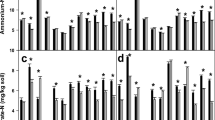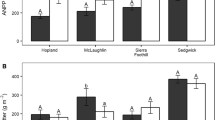Abstract
The effects of acidic deposition on agricultural soils have not received much attention because they are regularly limed and receive acid forming fertilizers far in excess of what would accumulate in these soils from atmospheric acidic deposition. However, not all agricultural soils are managed with equal intensity, and some may be prone to element specific effects from acidic deposition. Using data from the West Virginia University Soil Testing Laboratory and the National Atmospheric Deposition Program,it was found that soil Mg concentrations were decreasing up to 2.6% yr-1 in hay and pasture soils where acidic deposition was the highest. Rainfall amounts and biomass removaldid not appear to be related to this effect. By comparison, no trends in Mg depletion with acidic deposition were found for the more intensely managed home garden soils. Nor were there regional trends in Ca or K for either hay and pasture or home garden soils. While the correlation Mg depletion and acidic deposition does not in and of itself indicate causality, it does suggest the Mg status of unmanaged or moderately managed grasslands may be adversely affected by acidic deposition.
Similar content being viewed by others
References
Beverage, W. W., Strepus, W. J. and Hatfield, W. F.: 1968, Soil Survey of Barbour County, West Virginia, U.S. Dept. Agriculture/Soil Conservation Service, U.S. Government Printing Office, Washington, D.C.
Carpenter, S. G.: 1992, Soil Survey of Nicholas County, West Virginia, U.S. Dept. Agriculture/Soil Conservation Service, U.S. Government Printing Office, Washington, D.C.
Drohan, J. R. and Sharpe, W. E.: 1997, “Long-term changes in forest soil acidity in Pennsylvania, U.S.A.”, Water, Air, and Soil Pollut. 95, 299-311.
Ellyson, W. J., Fonner, R. F. and Kunkle, W. M.: 1970, Soil Survey of Wood and Wirt Counties, West Virginia, U.S. Dept. Agriculture/Soil Conservation Service, U.S. Government Printing Office, Washington, D.C.
Gorman, J. L. and Espy, L. E.: 1975, Soil Survey of Fayette and Raleigh Counties, West Virginia, U.S.Dept. Agriculture/Soil Conservation Service, U.S.Government Printing Office, Washington, D.C.
Gorman, J. L., Newman, L. S., Beverage, W. W. and Hatfield, W. F.: 1972, Soil Survey of Greenbrier County, West Virginia, U.S. Dept. Agriculture/Soil Conservation Service, U.S. Government Printing Office, Washington, D.C.
Johnson, D. W. and Todd, D. E.: 1990, “Nutrient cycling in forests of Walker Branch Watershed, Tennessee: Roles of uptake and leaching in causing soil changes”, J. Environ. Qual. 19, 97-104.
Joslin, J. D., Kelly, J. M. and Van Miegroet, H.: 1992, “Soil chemistry and nutrition of North American spruce-fir stands: Evidence for recent change”, J. Environ. Qual. 21, 1-30.
Kinniburgh, D. G., Jackson, M. L. and Syers, J. K.: 1976, “Adsorption of alkaline earth, transition, and heavy metal cations by hydrous oxide gels of iron and aluminum”, Soil Sci. Soc. Am. J. 40, 796-799.
Krug, E. C.: 1991, “Geographic Relationships between Soil andWater Acidity, Soil-Forming Factors, and Acid Rain”, in R. J. Wright, V. C. Baligar and R. P. Murrmann (eds), Plant-Soil Interactions at Low pH, Kluwer Academic Publishers, pp. 123-137.
Losche, C. K. and Beverage, W. W.: 1967, Soil Survey of Tucker County and Part of Northern Randolph County,West Virginia, U.S. Dept. Agriculture/Soil Conservation Service, U.S. Government Printing Office, Washington, D.C.
MacDonald, N. W., Burton, A. J., Liechty, H. O., Witter, J. A., Pregitzer, K. S., Mroz, G. D. and Richter, D. D.: 1992, “Ion leaching in forest ecosystems along a great lakes air pollution gradient”, J. Environ. Qual. 21, 614-623.
Malessa, V.: 1995, “Soil acidification gradients: Mode of development, status quo and classification”, Water, Air, and Soil Pollut. 84, 303-321.
Markewitz, D., Richter, D. D., Allen, H. L. and Urrego, J. B.: 1998, “Three decades of observed soil acidification in the Calhoun experimental forest: Has acid rain made a difference?”, J. Environ. Qual. 62, 1428-1439.
Mayer, R. and Ulrich, B.: 1977, “Acidity of precipitation as influenced by the filtering of atmospheric sulfur and nitrogen compounds - Its role in the element balance and effect on soil”, Water, Air, and Soil Pollut. 7, 409-416.
McBride, M. B.: 1978, “Retention of copper, calcium, magnesium and manganese by amorphous alumina”, Soil Sci. Soc. Am. J. 42, 27-31.
Myers, J. A., McLean, E. O. and Bigham, J. M.: 1988, “Reductions in exchangeable magnesium with liming of acid Ohio soils”, Soil Sci. Soc. Am. J. 52, 131-136.
National Atmospheric Deposition Program (NRSP-3)/National Trends Network: 2000, NADP Program Office, Illinois State Water Survey, 2204 Griffith Drive, Champaign, IL 61820.
Pierzynski, G.M., Sims, J. T. and Vance, G. F.: 2000, Soils and Environmental Quality, 2nd ed., CRC Press, Boca Raton, FL, 459 pp.
Pyle, R. E., Beverage, W. W., Yoakum, T., Amick, D. P., Hatfield, W. F. and McKinney, D. E.: 1982. Soil Survey of Randolph County AreaMain Part,West Virginia, U.S. Dept. Agriculture/Soil Conservation Service, U.S. Government Printing Office, Washington, D.C.
Smeck, N. E., Saif, H. T. and Bigham, J. M.: 1994, “Formation of a transient magnesium double hydroxide in soils of Southeastern Ohio”, Soil Sci. Soc. Am. J. 58, 470-476.
Sumner, M. E., Farina, P. M. W. and Hurst, V. J.: 1978, “Magnesium fixation - A possible cause of negative yield responses to lime applications”, Commun. Soil Sci. Plant Anal. 9, 995-1007.
Robarge, W. P. and Johnson, D. W.: 1992, “The Effects of Acidic Deposition on Forested Soils”, in D. L. Sparks (ed.), Advances in Agronomy, Vol. 47, American Society of Agronomy, Madison, WI, pp. 1-83.
Shortle, W. C. and Bondietti, E. A.: 1992, “Timing, magnitude and impact of acidic deposition on sensitive forest sites”, Water, Air, and Soil Pollut. 61, 253-267.
Tabatabai, M. A.: 1985, “Effect of acid rain on soils”, CRC Crit. Rev. Environ. Control 15, 65-110.
Topalanchik, A. R.: 1989, Soil Survey of Pleasants and Tyler Counties, West Virginia, U.S. Dept. Agriculture/Soil Conservation Service, U.S. Government Printing Office, Washington, D.C.
U.S. Department of Agriculture/Soil Conservation Service: 1979, General Soil Map of West Virginia, U.S. Department of Agriculture, Washington, D.C.
Van Eck, W. A.: 1978, “Summary of Soil Test Analyses for 1977”, Soil Fertility Information Series, No. 6, West Virginia University Cooperative Extension Service, Morgantown, WV.
West Virginia Department of Agriculture: 1987 to 2000, West Virginia Agricultural Statistics, Bulletins 18 to 31, Office of West Virginia Agricultural Statistics, Charleston, WV.
Author information
Authors and Affiliations
Corresponding author
Rights and permissions
About this article
Cite this article
McDonald, L.M., Balasko, J.A. Temporal Trends in Ca, Mg and K Concentrations of Grassland and Garden Soils in West Virginia, U.S.A. between 1986 and 1999. Water, Air, & Soil Pollution 146, 351–363 (2003). https://doi.org/10.1023/A:1023997602120
Issue Date:
DOI: https://doi.org/10.1023/A:1023997602120




